| 1982 MONTHLY PICTURE |
|
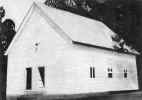 (click on picture to see an enlarged view) JANUARY - (Old Buck Creek Methodist Church - drawn by Tammy Costello - 9th grade) |
It is said that in 1805 a pioneer Methodist Circuit Rider, Rev. Lorenzo Dowell, passed through the Buck Creek Community in Allen County, then a part of Warren County. He expressed to a Mr. Hinton his wish to hold a revival in those woods next year. They set the date for the Brush Arbor Revival. The next year, 1806, the neighbors built a Brush Arbor, a pulpit and crude seats. On the day the revival started, people came for miles around in oxcarts and on horse back. Rev. Dowell arrived five minutes late, walked up into the pulpit, took his knife and stuck it into a tree and hung his hat on it. Then he preached and they had a great revival. The Old Buck Creek Methodist Church was organized in 1806 as a result of that revival. This first Methodist Church in the county has had three buildings on this site. The first church was built of logs; both the second and third were frame structures. The last church was said to have had lumber in it that came from the tree Rev. Dowell stuck his knife In and hung his hat on. This building burned in November, 1976. Due to the conflict of the Civil War, the Society, as the church organization was then called, divided and the New Buck Creek Methodist Church, South was organized. Old Buck Creek Church has had a great impact on the organization of other Methodist Churches in Allen County and the surrounding areas. |
 (click on picture to see an enlarged view) FEBRUARY - (Woods-Hall Ranch drawn by Billy Russell - 12th grade) |
Believed to have been built in 1814 by James Jones Foster, using slave labor, the house was a two story brick with walls two feet thick. Foster died in 1821 and he, with some members of his family, are buried within 200 yards of the home. After the death of their mother, the Foster heirs sold the approximately 2500 acres located in the bend of the Barren River, to their brother-in-law, John H. Page who conveyed the land to Uriah Porter and Edward P. Neal in 1857. On Jan. 2, 1883, Neal sold the land to L. D. Satterfield and it remained in the Satterfield family until 1911 when J. C. Satterfield sold the estate to E. P. Barlow. In 1913, E. P. Barlow sold the land to Edgar H. Woods of Rosedale, Miss. Gen. Woods was a veteran of the Spanish-American War and had operated plantations in the south. He quickly became known as a leader of agriculture in the state. Farm journals and out-of-state newspapers sent their reports to inspect the farm (at one time the largest farm in the state) and to interview Gen. Woods and his manager for 14 years, David Moyer from England. During most of Gen. Woods' ownership, the farm was mostly a stock farm with Hereford cattle imported from Montana. Sheep and hogs were also raised with corn, hay and tobacco. From time to time, the house was remodeled. It contained 7 bedrooms, reception hall, living room, dining room, large upstairs hall, bathroom, kitchen and large basement. Unfortunately, it was destroyed by fire in 1967. The farm was subdivided into smaller farms and sold at auction on Aug. 26, 1929. The sales brochure promised that a new Ford car and gifts of gold pieces would be given away at the sale. On July 13, 1961, the United States of America acquired most of the original Foster acreage for the Barren River Reservoir Project from Ms. Dorothy Spivey Burkholder, heir of Holiday Spivey, Franklin and Ruby Berry of Bowling Green; Euke Harston, L. P. House and Carl R. Pitchford, all of Allen County, a total of 1807 acres. |
 (click on picture to see an enlarged view) MARCH - (Store at Pope, Ky. drawn by Sherry Wade - 10th grade) |
The old Pope store building was first built near Butlersville on Trammel Creek in 1890. This building was dismantled and moved to the Pope community about 1900. There was a post office connected with the store until about 1908. Mr. and Mrs. Walter Lambert bought the store in 1919 from Will Roark. They operated the business in the old store building until 1947, decided to tear down the old building and erected what is now known as the Pope Store. Mr. Lambert passed away in 1960, but Mrs. Lambert continued to operate the business until she became disabled in 1977. The store then passed through a succession of owners until 1980 when it ceased all operation as a business. |
 (click on picture to see an enlarged view) APRIL - (Oil Well - drawn by Chris Calvert - 9th grade) |
This scene depicts the oil boom which occurred in Allen County during the early 1900's and contributed as much to the growth and development of the county. In the sketch, W. C. Barlow, brother of Duncan Barlow and the late Jack Barlow, is shown operating the Barlow rig as they struck a rich pool of oil in a strictly "wildcat" venture. Called "The Gusher," the free-flowing well was located in the yard of the Jack Barlow property on 31E South and continued to produce between 150 and 200 barrels of oil per day for at least a year. This well was drilled in 1918 or 1919. The first oil wells in Allen County were drilled in 1913 and, although short-lived, the county then enjoyed the reputation of having the greatest shallow oil field in the United States. |
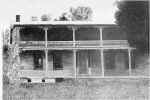 (click on picture to see an enlarged view) MAY - (The Asbury Napier Homeplace - drawn by Tim Gardner - 12th grade) |
The Asbury Napier Homeplace located on Long Creek in the Mt. Union community was originally acquired by the widowed Elizabeth Napier who came form Tennessee about 1830. Her son, Thomas, eventually came into possession of this farm. He purchased other land and acquired land grants until he owned about 800 acres. His children were: Emery, Louisa, Jacob, Fletcher, Mary Fletcher, Isaiah, Thomas, Elbridge, Asbury and Wilse. When Thomas divided the land among his sons, Asbury became owner of that portion upon which stood the homeplace. He was born in the house in 1863 and died there in 1946, never having moved away. The original home with slave quarters in the rear was built with logs hewn on the farm. In 1903 the front portion was added, forming an L. These materials were also cut on the farm. The carpenter for the addition was Millard Hanes who worked for $1.00 a day. The gingerbread trim and railing were cut out by hand. Members of this family were charter members of Mt. Union Methodist Church. There are over 700 known descendants who share the rich heritage generated from the Napier "Home Place." |
 (click on picture to see an enlarged view) JUNE - (Allen County National Bank - drawn by Carrie Wright - 8th grade) |
The Allen County National Bank was organized in 1899 and was located in a splendid brick building which is now occupied by the Dollar General Store. Its Board of Directors consisted of: f. H. Hale, Sr., President; L. S. Rogers, Vice President; A. S. Gardner, Head Cashier; W. W. Gardner, Assistant Cashier; Henry T. Motley; H. Cass Dobbs and Cal J. Guy. A 1907 edition of the Times-Messenger stated that the bank had a capital stock of $25,000.00 with surplus and undivided profits of $3500.00. The paper described the interior of the bank as "being fitted up after the style of handsome metropolitan banking houses." The bank had a fire-proof vault, one of the then latest makes of screw door-triple-time-lock safes. The main cashier, A. S. Gardner, father of W. W. Gardner, was a native of Elizabethtown, Ky., and came here from a bank in Leitchfield, which he had helped to organize. |
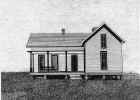 (click on picture to see an enlarged view) JULY - (The Joe Read Home - drawn by Tina Gardner - 12th grade) |
This house was built by Samuel James Read, Jr., in 1889. The land on which the house is built was given to S. J. Read by his father, Theophilus Read. It was part of the land acquired by Theophilus Read who came to Kentucky from Culpepper County, Virginia in 1811. The house is constructed entirely of yellow poplar logs cut from the land on which it is situated. Mr. and Mrs. Joseph E. Read, he being a great grandson of Theophilus Read, are the present owners and have lived there for many years. |
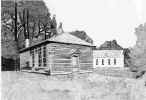 (click on picture to see an enlarged view) AUGUST - (Negro School at Maynard - drawn by Nathan Bratka - 8th grade) |
Maynard Colored School is located on Highway 98 just past the junction of Highway 1585 on the left. The school was built on the grounds of the Caney Fork Baptist Church, pictured in the background. Julius Rosenwald, a Caucasian *1862-1932), set aside the Rosenwald Fund to improve the opportunities and living conditions for Negroes in America in 1917. The fund contributed to the building of more than 5,000 rural Negro schools. This is how the present Maynard Colored School came to be. Nate Holder, Charlie Whitney and Henrietta Holder were instrumental in getting the school built. The building is a weather boarded structure with a coat room, kitchen and classroom. Garnett Holder, Jessie Hudson, Clara Whitney, Sarah Hughes and Nintha Shipley Ponds were some of the teachers in the system. The Allen County School Board maintained the school. It was closed in 1933 when the Allen County Colored Schools were consolidated with the city system. At present, the building which housed the school is used for homecomings, anniversaries, and other events of the Caney Fork Church. |
 (click on picture to see an enlarged view) SEPTEMBER - (Pre-Civil War view of West Main Street- drawn by Cheryl Denton - 12th grade) |
Looking down West Main Street from the old Octagon shaped courthouse, the first building on the left was the old Scottsville Hotel with its "stalls" out front for the loading and unloading of passengers and luggage. This building burned and was replaced with a pretty frame hotel with wrap-around porches. This hotel also burned and was replaced in 1919 with the Jacksonian Hotel which was razed in 1973. The Allen County Library stands on this location today. Just down the street from the old hotel is a livery stable (owner unknown). Next in view, (still on the left side) is the rental cottage owned by Misses Winnie and Fannie Brown, now the site of the residence of Mr. and Mrs. C. M. Carter, Jr. The next building is the historical Mulligan home, just recently purchased by Mr. and Mrs. Bill Reece. On the right side of the street is the home of Misses Winnie and Fannie Brown which was also the home of Scottsville's first telephone switchboard. This home was town down in 1962 and the City and County Building stands on this site today. |
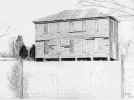 (click on picture to see an enlarged view) OCTOBER - (Gainesville Academy - drawn by Tonda Minix - 12th grade) |
This two-story frame building located at Gainesville and known as the Gainesville Academy was built probably in the mid 1800's. It is known that a new roof was required in the year 1878. The school offered twenty week courses on a collegiate level and lower, in scientific, commercial, teachers' preparatory, and music for $15.00 per twenty week term. Advanced as being situated in the most picturesque part of the village of Gainesville, board was offered in the homes of the best families at $1.00 to $2.00 per week. An 1888 ad lists E. P. Gillenwaters and L. N. Richards as principals of the academy. Sometime around the turn of the century, the second floor was used as a Masonic Lodge. Mrs. Jimmie Hollinger is the present owner of the building. |
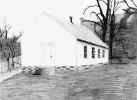 (click on picture to see an enlarged view) NOVEMBER - (Petroleum Free Methodist Church - drawn by Tina Borders - 11th grade) |
In the year of 1880, John William Walker Kelley and his wife Mary Elizabeth DeCamp Kelley came to Kentucky riding on the train to Petroleum to pioneer their new work. The first Camp Meeting that the Kelleys held was in July of 1889. At that time Petroleum was labeled as a "wicked town." In this Camp Meeting many were converted. There was such a change in the community people, that the president of the railroad showed his appreciation by giving the Kelley's a free pass over his railroad. Because of the efforts of the Kelleys, the Petroleum Free Methodist Church pictured here was built in 1890. Some of the pastors were Brothers Towns, Carter, Forester, Coats, Hibbett, Nipper, Drew, Wilson, Dearing, Permberton, Tinsley, Bixler, Taylor, Pepple and Robinson. This building was used until 1963, when the Petroleum and Scottsville churches merged to form the White Plains Free Methodist Church. Will T. Creasy is presently serving as pastor at White Plains. |
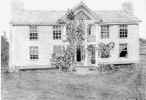 (click on picture to see an enlarged view) DECEMBER - (The George William Tabor Home - drawn by Susan Shook - 9th grade) |
This beautiful home was the residence of George William Tabor, grandson of Isaac Tabo(u)r, an early pioneer who settled on lands near Difficult Creek. The above pictured home was built in 1870 and is still standing. It is located about one mile off Highway 1332 near Liberty church and is owned by some of his descendants. Mr. Tabor and two of his wives, along with his parents and his grandparents, are buried in the Tabor Cemetery located near the house. During the Civil War an epidemic of measles swept the camp. Thought to be near death, he was sent home. However, while caring for him and their two small children, Amanda and Willie, his wife Maria was "stricken with gargle a dreaded throat infection and died." He recovered and married Margaret Goodrum. Their children were, Thomas Jefferson, James R., Henry, Elena, George Fount, Charles H., Johnnie Mae, and Sallie. |